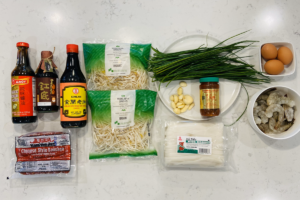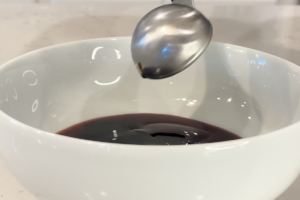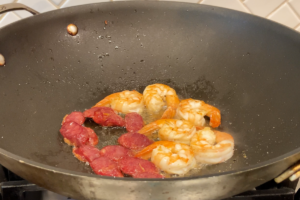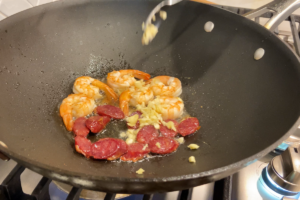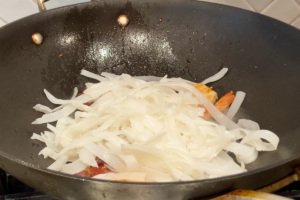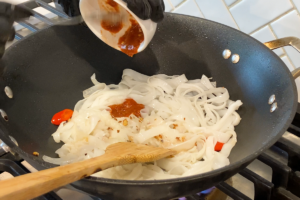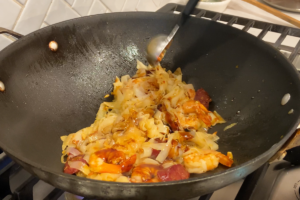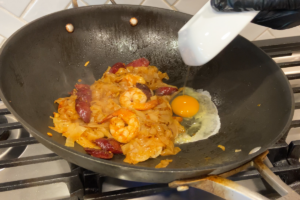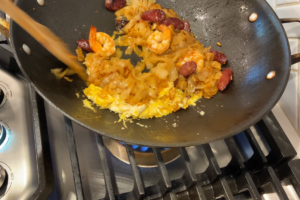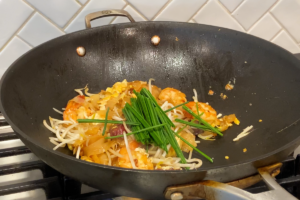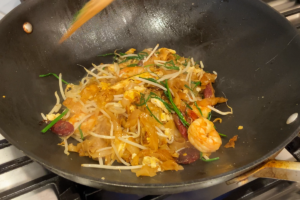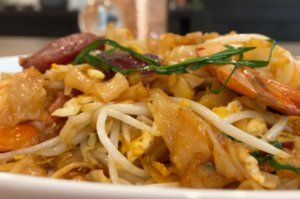Easy Char Kway Teow Recipe — A Taste of Malaysia at Home
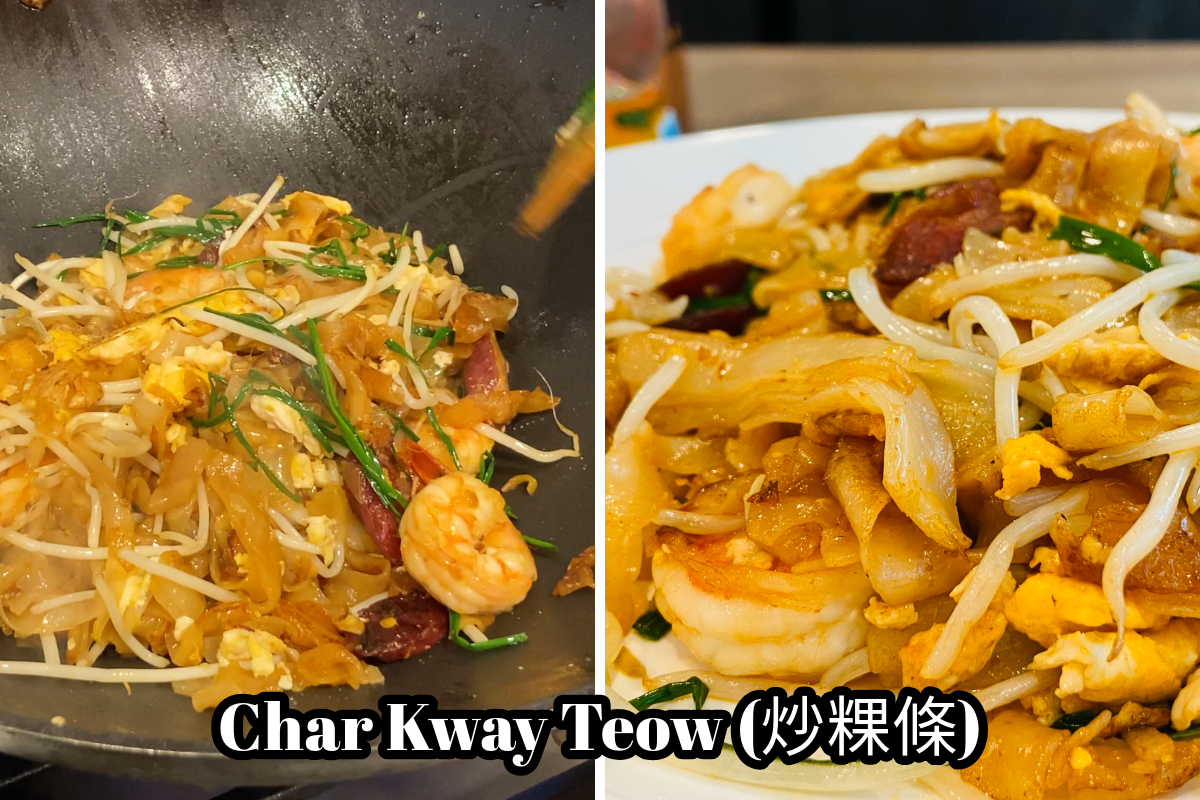
Want to enjoy a warm and tasty noodle dish that’s full of flavor? Char Kway Teow is a popular Malaysian stir-fried noodle dish that you can now make in your own kitchen. Made with soft rice noodles, shrimp, Chinese sausage (lap cheong), garlic chives, and a rich, savory sauce, this easy recipe is perfect for lunch or dinner. It brings the bold, comforting flavors of Malaysian street food right to your table.
What is Char Kway Teow?
Char Kway Teow means “stir-fried flat noodles” in Chinese. It began as a simple street food in Malaysia and Singapore, often made by workers and sold at local food stalls. Over time, it became one of the most loved noodle dishes in the region.
This dish packs deep flavor and a slightly smoky taste, thanks to cooking it quickly over high heat. Cooks usually serve it hot with shrimp, Chinese sausage, egg, bean sprouts, and garlic chives—all tossed together in a rich, dark sauce.
Pairing Suggestions for Char Kway Teow
Looking to round out your meal? Here are a few simple and tasty ideas that go well with Char Kway Teow:
- Stir-Fried Greens: try it with garlic stir-fried bok choy, spinach, or Chinese broccoli for a fresh and healthy side.
- Tofu with Soy Sauce: soft or crispy tofu topped with soy sauce and green onions adds a light, tasty bite.
- Spring Rolls: crunchy spring rolls or egg rolls are a fun and crispy addition to your meal.
- Dumplings: Steamed or pan-fried dumplings with soy dipping sauce make a great appetizer.
- Fish Balls or Wontons: These simple snacks are easy to enjoy before or alongside your noodles.
Final Thought
Char Kway Teow is one of Malaysia’s most famous noodle dishes—and now you can enjoy it at home. It’s full of flavor, fun to cook, and easy to adjust to your taste. Whether you’re making it for yourself or sharing with family and friends, it’s a great way to bring the flavors of Malaysian street food to your table.
Authentic Char Kway Teow (炒粿條) at Home
Equipment
- 1 wok
Ingredients
Sauce (for 3 servings)
- 2 tablespoons oyster sauce
- 2 tablespoons light soy sauce
- 2 tablespoons dark soy sauce
Rice Noodles (for 1 serving)
- 2 garlic cloves minced
- 6–8 oz fresh wide rice noodles
- 4 oz bean sprouts
- 1 bunch garlic chives cut into 2-inch pieces
- 4-5 medium shrimp peeled
- 6–8 slices slices Chinese sausage lap cheong
- 1 egg
- 1-2 teaspoons teaspoons chili paste like Sambal Belacan or Sambal Oelek
- Salt and pepper to taste
Instructions
- Gather ingredients: Prep all your ingredients ahead of time—this dish cooks quickly, and having everything ready makes the process smooth.
Make the sauce
- In a small bowl, mix together: oyster sauce, light soy sauce, and dark soy sauce.Tip: This amount makes enough for 3 servings. Use about 2 to 2½ tablespoons of the sauce per serving.
Sauté the shrimp and sausage
- Heat 1 tablespoon of oil in a wok or large skillet over high heat until it’s very hot. Swirl the oil around to coat the pan evenly. Add 6–8 slices of Chinese sausage (lap cheong) and 4–5 medium shrimp. Season with salt and pepper. Stir-fry for 30–45 seconds, or until the sausage starts to brown slightly and the shrimp turn pink. Tip: Avoid overcrowding the wok—cook in batches if needed to keep the heat high and maintain a good sear.
- Add 2 minced garlic cloves and stir-fry for another 10–15 seconds, just until fragrant (don’t let it burn).
Stir-fry the noodles
- Add 6–8 oz of fresh wide rice noodles to the wok. Gently toss them to loosen and warm them through.
- Add 1–2 teaspoons of sambal chili paste (Sambal Belacan or Sambal Oelek), depending on your spice preference.
- Pour in 2 to 2½ tablespoons of the sauce mixture. Stir and toss everything to coat the noodles evenly.
Add the egg
- Push the noodles to one side of the wok. Crack 1 egg into the empty side and let it cook for a few seconds.
- Scramble it gently with your spatula, then mix it into the noodles, shrimp, and sausage.
Add the vegetables
- Toss in 4 oz mung bean sprouts and a handful of garlic chives (cut into 2-inch pieces).
- Stir-fry for another 30 seconds, just until the vegetables are tender but still crisp.
Video
Notes
- Fresh is best: Use fresh rice noodles for the best texture.
- Loosen first: If using refrigerated noodles, let them come to room temperature or warm slightly to loosen before cooking.
- One at a time: Cook one serving at a time to keep the wok hot and avoid soggy noodles.
- Prep ahead: Have all ingredients prepped and ready before cooking—this dish comes together fast.


